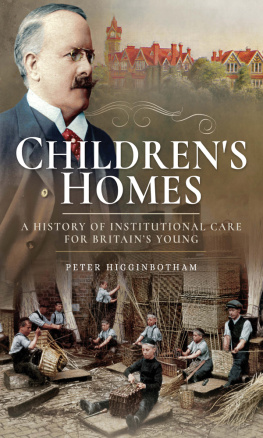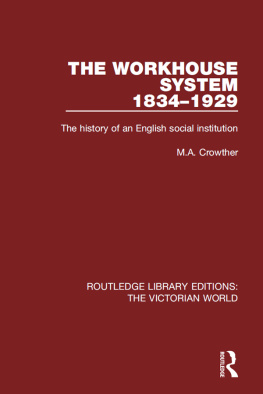Peter Higginbotham - Life in a Victorian Workhouse
Here you can read online Peter Higginbotham - Life in a Victorian Workhouse full text of the book (entire story) in english for free. Download pdf and epub, get meaning, cover and reviews about this ebook. year: 2011, publisher: Pitkin Unichrome Ltd, genre: Home and family. Description of the work, (preface) as well as reviews are available. Best literature library LitArk.com created for fans of good reading and offers a wide selection of genres:
Romance novel
Science fiction
Adventure
Detective
Science
History
Home and family
Prose
Art
Politics
Computer
Non-fiction
Religion
Business
Children
Humor
Choose a favorite category and find really read worthwhile books. Enjoy immersion in the world of imagination, feel the emotions of the characters or learn something new for yourself, make an fascinating discovery.
- Book:Life in a Victorian Workhouse
- Author:
- Publisher:Pitkin Unichrome Ltd
- Genre:
- Year:2011
- Rating:3 / 5
- Favourites:Add to favourites
- Your mark:
- 60
- 1
- 2
- 3
- 4
- 5
Life in a Victorian Workhouse: summary, description and annotation
We offer to read an annotation, description, summary or preface (depends on what the author of the book "Life in a Victorian Workhouse" wrote himself). If you haven't found the necessary information about the book — write in the comments, we will try to find it.
Life in a Victorian Workhouse — read online for free the complete book (whole text) full work
Below is the text of the book, divided by pages. System saving the place of the last page read, allows you to conveniently read the book "Life in a Victorian Workhouse" online for free, without having to search again every time where you left off. Put a bookmark, and you can go to the page where you finished reading at any time.
Font size:
Interval:
Bookmark:

Workhouse
Workhouse
Literature and Art
1536 Dissolution of the monasteries begins religious houses provided for the poor. | 1601 The Poor Relief Act makes parishes responsible for poor relief in England and Wales. |
1795 The Speenhamland system links labourers minimum wages to the price of bread. | 1834 The Poor Law Amendment Act creates a new poor relief system based on union workhouses. |
1837 Civil registration of births, marriages and deaths begins, administered by Poor Law Unions. | 1838 The Irish Poor Relief Act introduces the union workhouse system into Ireland. |
1842 Some unions allowed to give out relief to able-bodied men in return for work. | 1845 The Scottish Poor Law Act passed. Start of the Great Famine in Ireland. A scandal erupts over conditions at the Andover workhouse. |
1847 The Poor Law Commissioners replaced by the Poor Law Board. Married couples over the age of 60 in a workhouse can request a shared bedroom. | 1867 The Metropolitan Asylums Board created to provide care for Londons paupers with infectious diseases or mental impairment. |
1871 The Poor Law Board replaced by the Local Government Board. | 1900 A major overhaul of workhouse diets implemented. |
1905 A Royal Commission appointed to review the poor relief system. | 1909 Old Age Pensions introduced for the over-70s. The 1905 Royal Commissions reports published. |
1913 Workhouses become officially known as Poor Law Institutions. Children to be removed from workhouses by 1915. | 1919 Poor relief administration passes from the Local Government Board to the Ministry of Health. |
1930 The Local Government Act abolishes existing poor law authorities. Local councils now administer Public Assistance. | 1948 The National Health Service Act comes into operation on 5 July. |
Font size:
Interval:
Bookmark:
Similar books «Life in a Victorian Workhouse»
Look at similar books to Life in a Victorian Workhouse. We have selected literature similar in name and meaning in the hope of providing readers with more options to find new, interesting, not yet read works.
Discussion, reviews of the book Life in a Victorian Workhouse and just readers' own opinions. Leave your comments, write what you think about the work, its meaning or the main characters. Specify what exactly you liked and what you didn't like, and why you think so.













